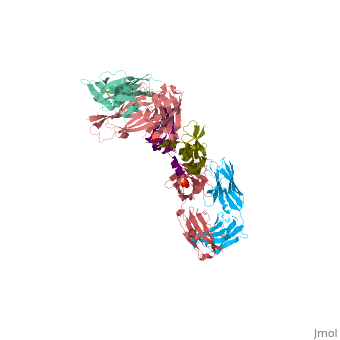VEGF IN COMPLEX WITH A NEUTRALIZING ANTIBODY
From Proteopedia
| Line 22: | Line 22: | ||
== Structural highlights == | == Structural highlights == | ||
| - | VEGF and anti-VEGF Fab Complex is a 6 chain, 1050 amino acid structure with a sequence taken from Homo sapiens and Mus musculus. | + | VEGF and anti-VEGF Fab Complex is a 6 chain, 1050 amino acid structure with a sequence |
| + | taken from Homo sapiens and Mus musculus. | ||
For a guided tour on the structure components use[http://oca.weizmann.ac.il/oca-docs/fgij/fg.htm?mol=1BJ1 FirstGlance] | For a guided tour on the structure components use[http://oca.weizmann.ac.il/oca-docs/fgij/fg.htm?mol=1BJ1 FirstGlance] | ||
VEGF is a <scene name='70/701451/Homodimeric_vegf/1'>homodimeric</scene> protein who belongs to the family of cystine knot growth factors. | VEGF is a <scene name='70/701451/Homodimeric_vegf/1'>homodimeric</scene> protein who belongs to the family of cystine knot growth factors. | ||
Revision as of 07:53, 16 August 2015
| |||||||||||
Publication Abstract from PubMed
BACKGROUND: Vascular endothelial growth factor (VEGF) is a highly specific angiogenic growth factor; anti-angiogenic treatment through inhibition of receptor activation by VEGF might have important therapeutic applications in diseases such as diabetic retinopathy and cancer. A neutralizing anti-VEGF antibody shown to suppress tumor growth in an in vivo murine model has been used as the basis for production of a humanized version. RESULTS: We present the crystal structure of the complex between VEGF and the Fab fragment of this humanized antibody, as well as a comprehensive alanine-scanning analysis of the contact residues on both sides of the interface. Although the VEGF residues critical for antibody binding are distinct from those important for high-affinity receptor binding, they occupy a common region on VEGF, demonstrating that the neutralizing effect of antibody binding results from steric blocking of VEGF-receptor interactions. Of the residues buried in the VEGF-Fab interface, only a small number are critical for high-affinity binding; the essential VEGF residues interact with those of the Fab fragment, generating a remarkable functional complementarity at the interface. CONCLUSIONS: Our findings suggest that the character of antigen-antibody interfaces is similar to that of other protein-protein interfaces, such as ligand-receptor interactions; in the case of VEGF, the principal difference is that the residues essential for binding to the Fab fragment are concentrated in one continuous segment of polypeptide chain, whereas those essential for binding to the receptor are distributed over four different segments and span across the dimer interface.
VEGF and the Fab fragment of a humanized neutralizing antibody: crystal structure of the complex at 2.4 A resolution and mutational analysis of the interface.,Muller YA, Chen Y, Christinger HW, Li B, Cunningham BC, Lowman HB, de Vos AM Structure. 1998 Sep 15;6(9):1153-67. PMID:9753694[1]
From MEDLINE®/PubMed®, a database of the U.S. National Library of Medicine.
</div>

